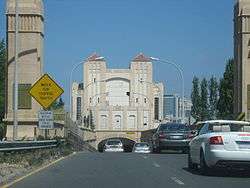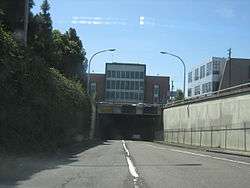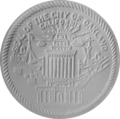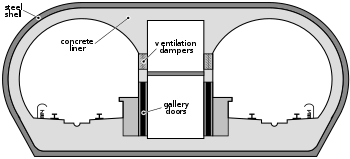Posey and Webster Street tubes
Coordinates: 37°47′15″N 122°16′36″W / 37.787535°N 122.276628°W
| Overview | |
|---|---|
| Location | Alameda, California and Oakland, California |
| Coordinates | 37°47′16″N 122°16′38″W / 37.78778°N 122.27722°W |
| Route |
(Signed as |
| Operation | |
| Opened |
October 27, 1928 (Posey tube) 1963 (Webster St. tube) |
| Operator | California Department of Transportation |
| Technical | |
| No. of lanes | 2 per each tube |
| Tunnel clearance |
14.67 feet (4.47 m) (Posey tube) 14.83 feet (4.52 m) (Webster St. tube) |


The Posey tube and the Webster Street tube are two parallel underwater tunnels connecting the cities of Oakland and Alameda, California, running beneath the Alameda–Oakland Estuary. The Posey tube carries Oakland-bound traffic under the Estuary, while the Webster tube carries traffic bound for Alameda.
The Posey tube is the second-oldest underwater vehicular tunnel in the US, preceded only by the Holland Tunnel.
Construction
The Posey tube, an immersed tube completed and opened to traffic on October 27, 1928, was named after George Posey, Alameda County Surveyor during the tunnel's planning and construction, and also chief engineer on the construction project. The Webster Street tube opened in 1963 to deal with the increased traffic between Oakland and Alameda. Both are immersed tubes, constructed by sinking precast concrete segments to a trench in the Estuary floor, then sealing them together to create a tunnel. The Posey tube replaced a swing bridge that interfered with maritime traffic. The ventilation buildings that house the exhaust and fresh air fans are built in an art deco style.[1]
The ventilation of toxic vehicular exhaust fume design was modeled on that of the Holland Tunnel's ventilation system, and Ole Singstad (who had designed the pioneering ventilation system of the Holland Tunnel) consulted.[2]
References
- ↑ "Building Spotlight: Historic Posey Tube and 2016 Renovation Plan". Jack London Improvement District. Retrieved 2017-06-12.
- ↑ Saga in Steel and Concrete, pp. 191–202 Archived 2015-09-26 at the Wayback Machine.
External links
- Posey tube and Webster Street tube at AlamedaInfo.com by Gary Lenhart (includes detailed timeline and historical photographs)
- Bjork, Kenneth (1947), Saga in Steel and Concrete: Norwegian Engineers in America, Norwegian-American Historical Association
- Methods Used in the Construction of Twelve Pre-cast Concrete Segments for the Alameda County, California, Estuary Subway, in American Society of Civil Engineers, Proceedings, 53 (2) : 2675–2692 (December, 1927)
- S. W. Gibbs,Construction Methods on Oakland Estuary Tube, in Engineering News Record, 100:100–105 (January 19, 1928)
- Building Big David Macauley ISBN 0-395-96331-1 A companion to PBS television series Building Big series PAGES 76–77 explain ventilation system for Holland Tunnel
- Byron, Wm. C. (14 November 1928). "Setting forth merits of the vehicular tube". Coronado Eagle and Journal. Retrieved 2 May 2017.


